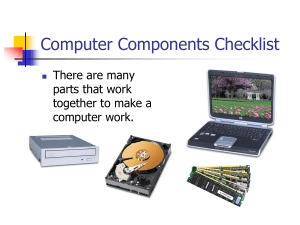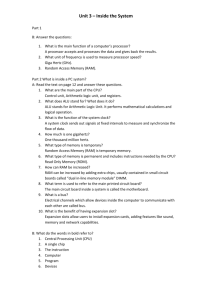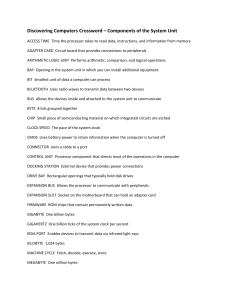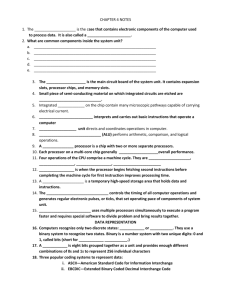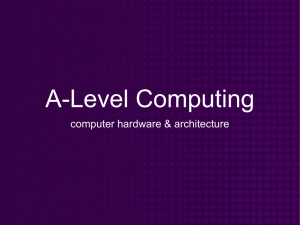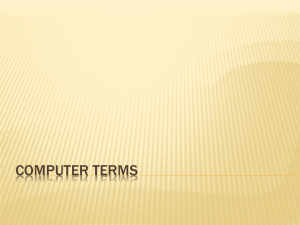The Components of the System Unit Chapter 4
advertisement
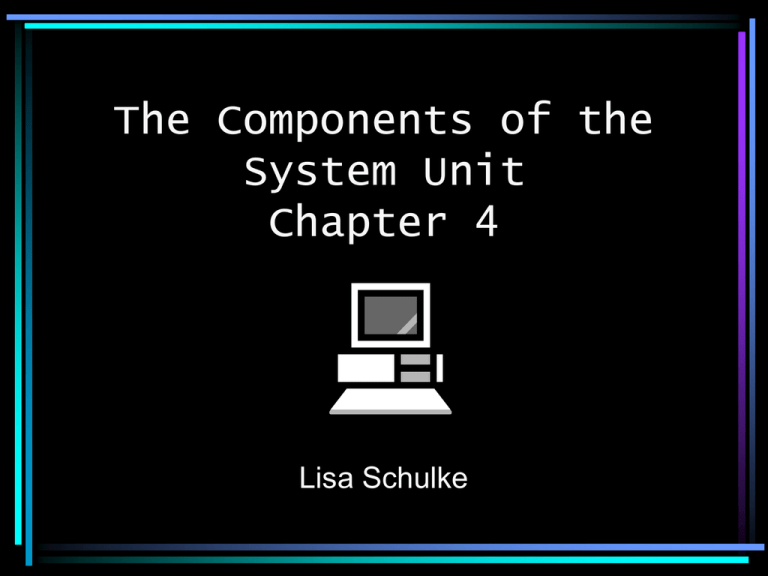
The Components of the System Unit Chapter 4 Lisa Schulke What exactly is the System Unit? • A case that contains electronic components used to process data • Sometimes called the chassis which protects the internal electronic components – Includes the Motherboard which is the main circuit board of the system unit More about the Motherboard • Many electronic components attach to the board • Those components include: adapter cards, the processor, and memory chips – A computer chip is a small piece of semi conducting material which have integrated circuits • Other components are built into the board The Processor A component • central processing unit • Interprets & carries out basic instructions that operate a computer • Manages the computer’s operations • Contain 2 smaller components – Control unit The Control Unit • Directs & coordinates operation • Interprets each instruction issued by a program & initiates the appropriate action to carry out the instruction The Arithmetic Logic Unit • Arithmetic operations – Basic calculations • Comparison operations – Comparing 1 data to another • Logical operations – And, or, and Not The Machine Cycle: 4 basic operations of a processor 1. Fetching- obtaining a program instruction or data from the memory 2. Decoding- translating instructions into signals 3. Execute- carries out the commands 4. Storing- writing result to memory Plenty more about processors • Contains: – A register which is storage location that temporarily holds data and instructions – A system clock that control the timing of computer operations • Clock speed Names of Processors • Pentium- used by high performance PCs • Celeron- used by less expensive basic PCs • Xeon and Itanium- ideal for workstations and low-end servers Processor Installation and Upgrades • 3 types of Upgrades – Chip-for-chip – Piggyback – Daughterboard New chips cause heat • A heat sink is a small ceramic component that absorbs and ventilates heat produced by electrical components • A heat pipe cools processors in notebook computers Coprocessors and Parallel Processing • A coprocessor is a special chip or circuit board that assists the processor in performing tasks – Floating point has numeric capabilities • Parallel processing is a method that uses multiple processors to execute a program. Data Representation • Computers communicate digitally and recognize only 2 discrete states: on and off – recognizes the 2 states by the binary system which only has 2 unique digits( 0 & 1), called bits • 8 bits form a byte Coding scheme • The combinations of 0s and 1s that represent characters are defined by patterns called the coding scheme – Example: #3 is represented by 00110101 • The 2 popular coding schemes: – ASCII and EBCDIC Memory • Consists of electronic components that store instructions waiting to be executed by the processor, data, and the results of processed data (info) What memory stores? • 3 basic categories of items: – The operating system and other system software that control or maintain the computer and its devices – The application programs that carry out a specific task, such as word processing – The data being processed by the application programs and resulting information More about Memory • A byte resides temporarily in a location called the address – An address is a unique number that identifies the location of the byte • To access data in memory, the computer references the addresses that contain bytes of data Sizes of Memory • • • A kilobyte is equal to exactly 1,024 bytes A megabyte is equal to almost 1 million bytes A gigabyte equals almost 1 billion bytes 2 types of Memory 1. Volatile- when the computer’s power is turned off it loses its contents 2. Nonvolatile- does not lose its contents Ram • Stands for Random access memory or main memory • Consists of memory chips that can be read from and written to by the processor • It can hold multiple programs simultaneously • Most Ram is volatile 2 basic types of ram chips • Dynamic Ram – Must be reenergized constantly or they lose their contents • Static Ram – Do not have to be reenergized as often – More expensive – Faster and more reliable Where do RAM chips live? • Usually reside on a memory module which is a small circuit board – Memory slots on the motherboard hold memory modules • 3 types of modules: – SIMMS (single inline memory module) – DIMMS (dual inline memory module) – RIMMS Ram Configurations • The amount of RAM necessary in a computer often depends on the types of software you plan to use • The more RAM a computer has, the faster it • A software package will indicate the minimum amount of RAM it requires Cache: speeds up process • Memory cache helps speed the processes of the computer because it stores used instructions and data – L1 cache has the smallest capacity – L2 cache has a larger capacity than L1 – L3 cache exists only with L2 advanced transfer cache • Disk cache Read-only memory • ROM refers to memory chips storing permanent data • Data can’t be modified • ROM is nonvolatile • Rom chips are called firmware which contain permanently written data/info • A PROM (programmable) chip is a blank ROM which a programmer can write Flash Memory • A type of nonvolatile memory • Can be erased electronically and reprogrammed • Useful for updates • Flash memory cards store flash memory on a removable device instead of a chip An aide to chips • Complementary metal-oxide semiconductor (CMOS) – Technology that provides high speeds – Consumes little power – Uses battery power to retain info Memory Access Times • Access time is the time it takes the processor to read data/info – Directly effects how fast the computer runs – Nanoseconds and MHz are used to state access times – Accessing data from memory is faster than from hard disk Expansion slots and adapter cards • The slot is a socket that holds adapter card • An adapter card is a circuit board (expansion card) – Enhances functions – Provides connections to peripherals • A peripheral connects to the system unit and is controlled by the processor –Examples: modems, printers, scanners Neat cards • A sound card enhances sound by allowing sound to be input thru a microphone and output thru speakers • A video card converts output info into a signal which displays an image on the screen • A modem card allows computer to communicate via telephone lines, cable, etc.. • A network card allows computer to access a network Pc cards and Flash memory cards • A PC Card slot is an expansion slot that holds PC cards – A PC card adds memory, storage, sound, fax/modem & communications – PC cards are 1 type of flash memory card • A flash memory card allows users to transfer data from mobile devices to desktop computers Ports and Connectors • The point where the peripheral connects to the system unit • Send data • The term jack is used to identify audio/video ports • Personal computers have ports in front • Others have in back • Joins a cable to a peripheral • 2 genders of cables: – Male- 1+ exposed pins – Female-have matching holes to accept the pins • Same gender can’t connect • Gender changer- join same gender connectors Serial Ports • Interface that connects a device to the system by transferring bit by bit • Connect devices that don’t require fast data • Examples: mouse, keyboard • The COM port is a type of serial port Parallel Ports • Interface that connects devices by transferring more than 1 bit at a time • Printers are connected by this port • Also called a Centronics interface USB Ports • • • • Short for Universal serial bus port Can connect up to 127 different peripherals Uses only 1 single connector type To attach multiple peripherals use Daisy chain – The 1st USB device to the USB port on the computer, then the 2nd connects to 1st and so on • USB hub- plugs into USB port and contains multiple USB ports Special-Purpose Ports • Firewire- connect devices that require faster speeds • Midi- connects the system unit to a musical instrument • SCSI (small computer system interface)connects disk drives and printers • IrDa- transmits data via infrared light waves • Bluetooth- transmits data using radio waves Buses • Electrical channels that bits transfer on • Allows inside and outside devices to communicate with each other • Consists of 2 parts: – A data bus transfers actual data – An address bus transfers info where the data is • Bus width- the # of bits the computer can transmit at 1 time Word Size and buses • The number of bits the processor can interpret and execute at a give time • Every bus has a clock speed (hertz) • 2 basic types of buses: – A system bus connects to main memory – An expansion bus connects to peripherals Expansion Bus • Communicates with peripherals attached to adapter card • Types: – ISA (Industrial Standard Architecture)most common – Local- a high speed expansion that connects higher speed devices – AGP (Accelerated Graphics Port)designed to improve the speed with 3-D graphics – FireWire- eliminate the need to install cards Power Supply • Converts the wall outlet AC power into DC power • Near the supply is a fan to keep unit cool • Some external peripherals have an AC adapter, which is an external power supply Putting it all together • Many components of the system unit influence the speed and power of the computer • These include: – Type of processor – Clock speed of the processor – The amount of RAM – Clock speed of the bus Chapter Summary • Components of the system unit • Described how memory stores data/info • Discussed sequence of operations that occur when a computer executes an instruction
